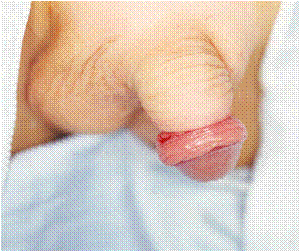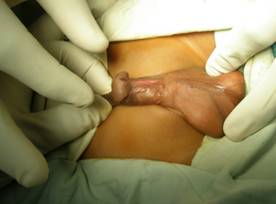Circumcision is the term used for minor surgery in which a portion of the excess skin at the tip of the penis (preputial skin) is removed.
Indication
In Malaysia, circumcision is usually done for religious reasons or as ‘ritual circumcision’ in which the circumcision procedure is done on a normal penis. Certain medical conditions may require circumcision such as a condition called phimosis where the skin at the tip of the penis is narrow and blocks the flow of urine or paraphimosis, which is the result of the fore skin being stuck behind the glans penis.

Paraphimosis occurs when the skin is pulled and stuck behind the glans penis. It results in constriction at the proximal corona.
There are also cases where circumcision is done because of abnormalities in the skin of the penis or circumcision is done to facilitate the insertion of tube in the urinary tract of patients who need to do ‘clean self -catheterization’.
Conditions such as bladder not functioning properly can expose the patient to urinary tract infections; this situation requires urine to be removed from the bladder by inserting a tube into the urinary tract. Therefore, to facilitate the insertion of the tube into the urinary tract, the excess skin at the tip of the penis is removed following circumcision procedures. There are also cases in which circumcision is done because of the injury to the skin at the tip as when the skin on the penis gets caught in the zip of pants. (see picture)

Skin at the tip of penis is caught in the zip
In some cases the preputial skin may be required for reconstruction of congenital abnormality in the genitelia. In conditions such as hypospadias, epispadias, chordae, buried penis and micropenis, circumcision should be avoided or postponed.

Hypospadias in which the urethra and the ventral skin are not formed properly. Penis may also be bent or rotated.
Circumcision techniques
In general circumcision is done among two main age groups; it is either during the newborn period, in which case is called ‘Neonatal Circumcision’ or when the child reaches the age of around 7-12 years. Circumcision is also sometimes done as an additional procedure during surgery such as during a hernia operation.
Plastibell Method
Circumcision for the newborn is usually performed using local anesthesia. Due to the size of the penis of the newborn being very small, this procedure should be done by experts who are fully trained to do the procedure, if not, there is a high risk of complications arising from the procedure. To perform circumcision on the baby, usually the plastibell procedure is used.

The figure above demonstrates the circumcision procedure using plastibell. After a slit is made in the preputial skin, the plastibell is mounted on the glans. The outer skin is ligated against the plastibell groove. The excess preputial skin is removed.
Circumcision in older children is also performed under local anesthesia. But to do this, children should be mentally prepared to cope with the procedure. If a child is not ready or too afraid to face the procedure, then the procedure should not be continued because it increases the risk of complications.
Before circumcision is performed, detailed inspection should be done on the penis and if there is any abnormality of the penis, then the patient should be referred to a pediatric surgeon for further examination.
We must ensure that patients do not have bleeding problems such as hemophilia, and the like, because if patients have bleeding problems, the bleeding may not stop after circumcision is done.
For children who have mental problems or problems of bleeding, the National Fatwa Council will exempt them from undergoing circumcision.
For children who do not get circumcised under the influence of local anesthesia, they can be considered for the circumcision under general anesthesia depending on the doctor’s evaluation and the merits of the case.
There are two main methods to perform circumcision, that is, freehand or using a clamp. In the case of free hand there are two methods, using a dorsal slit or ‘guillotine’ method.
Dorsal slit method is considered more secure because it has a lower risk of injury to the glans penis compared to the ‘guillotine’ method.
Dorsal slit method
- Penis is cleaned.
- Preputial skin is separated from glans penis and smegma removed.
- Penis is cleaned again.
- Local anesthesia is given.
- 1 artery forcep is placed on the frenulum and 2 artery forceps are placed in the 12 o’clock position.
- Skin is cut from the 12 o’clock position until the skin in the prepuce is 0.3 cm from the corona.
- Skin is cut around the penis maintaining a distance of 0.3 cm from the corona but leaving a little more at the frenulum.
- Bleeding should be stopped using bipolar technique or by tying the blood vessels (the use of monopolar diathermy should be avoided because it can disrupt the blood supply to the penis and cause damage to the penis).
- The skin is sutured with strings made from readily absorbable material.
- There is no need for dressing.
Clamping method
There are various types of clamps in the market to perform circumcision. However , before using any of the clamps, the medical practitioner must be adequately trained to use the clamp to avoid complications. Generally the clamp has two components.
The first component is the part that protects the glans penis and the second is the part that clasps the prepuce skin layer with the inner(first) layer. With this, blood will not flow to the skin and the skin will die. Clamping prevents bleeding and there is no need for stitching.
There are cases where the clamp does not come off itself, in which case the clamp had to be removed manually.
The procedure for clamping:
- Ensure that medical practitioners are trained to use the clamp.
- Make sure the size of the clamp is suitable for the patient, this is because the clamp comes in different sizes.
- Clean the penis.
- Give local anesthesia.
- Divide the glans penis from the prepuce.
- Perform a dorsal slit.
- Place the protective layer over the glans penis and make sure it is set properly.
- Pull the prepuce skin and place it in between the clamp.
- Lock the clamp.
- Clamp will fall on its own within 7-10 days; if not, it should be removed manually.
Complications of Circumcision
- Bleeding; if bleeding occurs do gentle compression, if the bleeding continues seek the assistance of a doctor to stop the bleeding.
- Infection; make sure the place where the surgery is performed is always clean so as to prevent infection, if infection occurs, seek medical treatment.
- Injury to the penis must be avoided by performing the procedure carefully. In the event of an injury, it must be treated immediately.
- Urinary problems; if the patient experiences urinary problems after circumcision, immediate medical attention should be given.
| Last Reviewed | : | 19 September 2013 |
| Writer | : | Mr. Wan Usamah b. Wan Husein |







